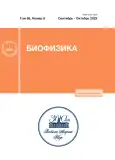Effect of taxifolin, a conjugate of taxifolin with glyoxylic acid, and naringenin on the functional activity of neutrophils
- Autores: Shubina V.S1, Kobyakova M.I1, Shatalin Y.V1
-
Afiliações:
- Institute of Theoretical and Experimental Biophysics, Russian Academy of Sciences
- Edição: Volume 68, Nº 5 (2023)
- Páginas: 941-948
- Seção: Articles
- URL: https://journals.rcsi.science/0006-3029/article/view/233464
- DOI: https://doi.org/10.31857/S0006302923050149
- EDN: https://elibrary.ru/PHHMYB
- ID: 233464
Citar
Texto integral
Resumo
Palavras-chave
Sobre autores
V. Shubina
Institute of Theoretical and Experimental Biophysics, Russian Academy of Sciences
Email: shubinavictoria@yandex.ru
Pushchino, Moscow Region, Russia
M. Kobyakova
Institute of Theoretical and Experimental Biophysics, Russian Academy of SciencesPushchino, Moscow Region, Russia
Yu. Shatalin
Institute of Theoretical and Experimental Biophysics, Russian Academy of SciencesPushchino, Moscow Region, Russia
Bibliografia
- Н. В. Воробьева, Вестн. Моск. ун-та. Сер. 16. Биология, 75 (4), 210 (2020).
- М. А. Челомбитько, Вестн. Моск. ун-та. Сер. 16. Биология, 73 (4), 242 (2018).
- М. Laforge, C. Elbim, C. Frbre, et al., Nat. Rev. Immunol. 20 (9), 515 (2020).
- A. Herrero-Cervera, O. Soehnlein, E. Kenne, Cell. Mol. Immunol., 19 (2), 177 (2022).
- V. Papayannopoulos, Nat. Rev. Immunol., 18 (2), 134 (2018).
- D. Ribeiro, M. Freitas, S. M. Tomd, et al., Eur. J. Med. Chem., 67, 280 (2013).
- D. Ribeiro, E. Fernandes, and M. Freitas, In Flavonoids as Modulators of Neutrophils' Oxidative Burst: Structure-Activity Relationship. Polyphenols: Mechanisms of Action in Human Health and Disease (Acad. Press, 2018), Chapter 20.
- T. Kirchner, E. Hermann, S. Moller, et al., Mediators Inflamm., 2013, 710239 (2013).
- M. M. de Souza Andrade, V. N. C. Leal, I. G. Fernandes, et al., Antioxidants (Basel), 11 (9), 1690 (2022).
- G. S. Pereira, I. Percebom, S. Mendes, et al., Braz. J. Biol., 84, e252936 (2022).
- M. Saffarzadeh, H. A. Cabrera-Fuentes, F. Veit, et al., Discoveries (Craiova), 2 (2), e19 (2014).
- M. Monobe, K. Ema, Y. Tokuda, et al., Cytotechnology, 62 (3), 201 (2010).
- S. Cui, J. Qian, P. Bo, J. Tradit. Chin. Med., 33 (6), 804 (2013).
- G. Berton, S. R. Yan, L. Fumagalli, et al., Int. J. Clin. Lab. Res., 26 (3), 160 (1996).
- А.А. Галкин и В.С. Демидова, Раны и раневые инфекции. Журнал имени проф. Б.М. Костючёнка, 2 (2), 25 (2015).
- R. Cannataro, A. Fazio, C. La Torre, et al., Antioxidants (Basel), 10 (2), 328 (2021).
- A. R0dtjer, L. Skibsted, and M. L. Andersen. Eur. Food Res. Technol., 223, 663 (2006).
- B.F. de Simbn, M. Sanz, E CadaWa, et al., Food Chem., 143, 66 (2014).
- J. Cai, H. Wen, H. Zhou, et al., Biomed. Pharmacother., 164, 114990 (2023).
- Y. Liu, X. Shi, Y. Tian, et al., Front. Pharmacol., 14, 1173855 (2023).
- A. Duda-Madej, J. Stecko, J. Sobieraj, et al., Antibiotics (Basel), 11 (11), 1628 (2022).
- D.Yang, R. Zhu, H.-X. Xu, et al., Food Bioscience, 53, 102811 (2023).
- M. Chen, H. Zhou, C. Huang, et al., Food Chem., 377, 132008 (2022).
- M. Chen, P. Liu, H. Zhou, et al., Front. Nutr., 9, 973048 (2022).
- V. S. Shubina and Yu. V. Shatalin, J. Food Sci. Technol., 54 (6), 1467 (2017).
- M.T. Quinn and F.R. DeLeo, Neutrophil: Methods and Protocols. Methods in Molecular Biology, 2087 (Springer, 2020).
- N. Beloborodova, I. Bairamov, A. Olenin, et al., J. Biomed. Sci., 19 (1), 89 (2012).
- A. K. Gupta, S. Giaglis, P. Hasler, et al., PLoS One, 9 (5), e97088 (2014).
- S. Yousefi, D. Stojkov, N. Germic, et al., Eur. J. Immunol., 49 (2), 221 (2019).
- H. R. Thiam, S. L. Wong, D. D. Wagner, et al., Annu. Rev. Cell. Dev. Biol., 36, 191 (2020).
- A. Herrero-Cervera, O. Soehnlein, and E. Kenne, Cell. Mol. Immunol., 19 (2), 177 (2022).
- Baiula, R. Greco, L. Ferrazzano, et al., PLoS One, 15 (8), e0237746 (2020).
- S. de Oliveira, E. Rosowski, and A. Huttenlocher, Nat. Rev. Immunol., 16 (6), 378 (2016).
- V. S. Shubina, V. I. Kozina, and Yu. V. Shatalin, Antioxidants (Basel), 10 (8), 1262 (2021).
Arquivos suplementares









